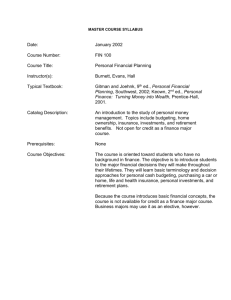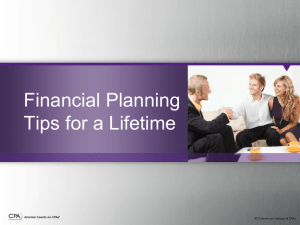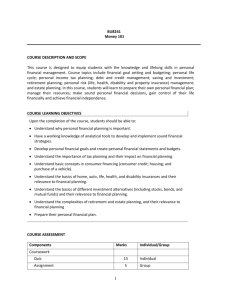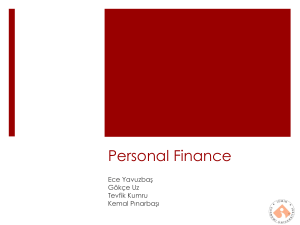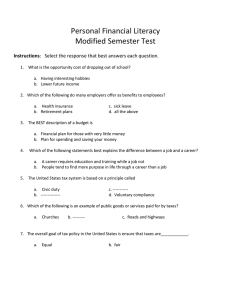BAS 120
advertisement
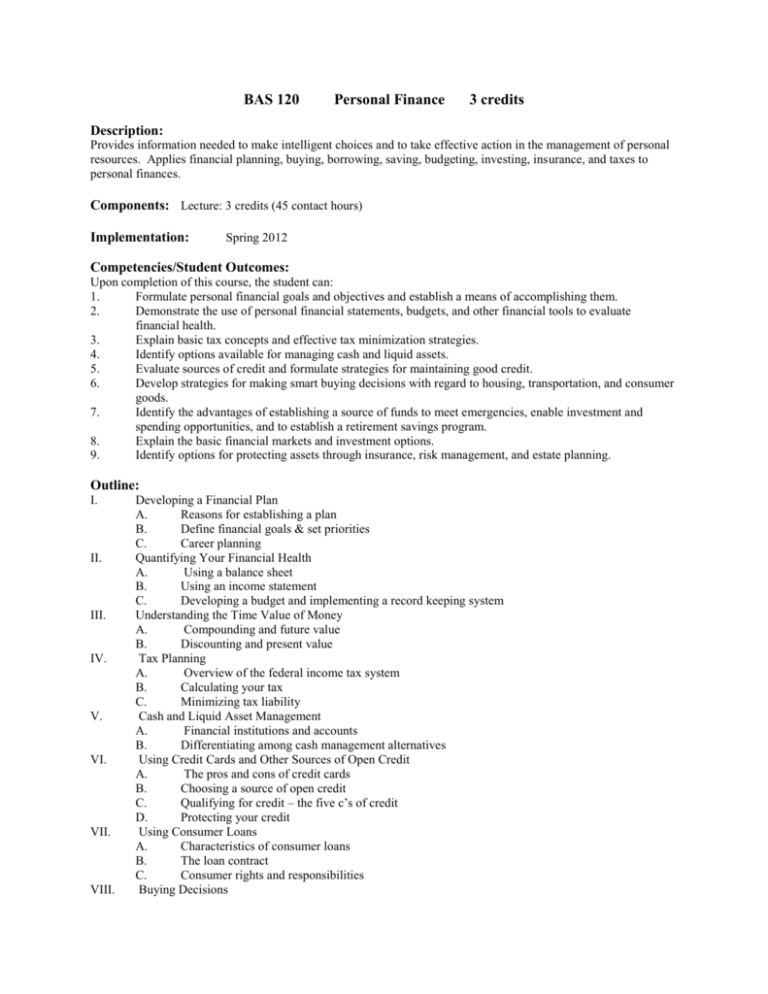
BAS 120 Personal Finance 3 credits Description: Provides information needed to make intelligent choices and to take effective action in the management of personal resources. Applies financial planning, buying, borrowing, saving, budgeting, investing, insurance, and taxes to personal finances. Components: Lecture: 3 credits (45 contact hours) Implementation: Spring 2012 Competencies/Student Outcomes: Upon completion of this course, the student can: 1. Formulate personal financial goals and objectives and establish a means of accomplishing them. 2. Demonstrate the use of personal financial statements, budgets, and other financial tools to evaluate financial health. 3. Explain basic tax concepts and effective tax minimization strategies. 4. Identify options available for managing cash and liquid assets. 5. Evaluate sources of credit and formulate strategies for maintaining good credit. 6. Develop strategies for making smart buying decisions with regard to housing, transportation, and consumer goods. 7. Identify the advantages of establishing a source of funds to meet emergencies, enable investment and spending opportunities, and to establish a retirement savings program. 8. Explain the basic financial markets and investment options. 9. Identify options for protecting assets through insurance, risk management, and estate planning. Outline: I. II. III. IV. V. VI. VII. VIII. Developing a Financial Plan A. Reasons for establishing a plan B. Define financial goals & set priorities C. Career planning Quantifying Your Financial Health A. Using a balance sheet B. Using an income statement C. Developing a budget and implementing a record keeping system Understanding the Time Value of Money A. Compounding and future value B. Discounting and present value Tax Planning A. Overview of the federal income tax system B. Calculating your tax C. Minimizing tax liability Cash and Liquid Asset Management A. Financial institutions and accounts B. Differentiating among cash management alternatives Using Credit Cards and Other Sources of Open Credit A. The pros and cons of credit cards B. Choosing a source of open credit C. Qualifying for credit – the five c’s of credit D. Protecting your credit Using Consumer Loans A. Characteristics of consumer loans B. The loan contract C. Consumer rights and responsibilities Buying Decisions IX. X. XI. XII. XIII. XIV. A. The housing decision – renting v. Buying B. Purchasing transportation C. Making smart consumer purchases Investment Basics A. Setting priorities for investments B. Acquiring funds for investments C. Risk-return and market rates Securities Markets A. How stocks and bonds are traded B. Sources of investment information Investment Choices and Asset Allocation A. Stocks B. Bonds C. Real estate D. Gold, silver, gems & collectibles E. Mutual funds Retirement Planning A. Sources of retirement income B. Putting a plan together and monitoring it C. Tax issues related to retirement savings Protecting Your Assets With Insurance A. Life insurance B. Disability insurance C. Property insurance D. Automobile insurance Estate Planning A. Wills B. Trusts Learning Resources: Kapoo, J., Dlabay, L., & Hughes, R. (2007). Personal finance (8th ed.). Irwin, CA: McGraw-Hill. Keown, A. (2007). Personal finance: Turning money into wealth (4th ed.). Upper Saddle River, NJ: Prentice Hall. Garman, E. T. (2008). Personal finance (9th ed.). New York, NY: Houghton Mifflin. Gitman, L., & Joehnk, M. (2008). Personal financial planning (10th ed.). New York, NY: Thomson. Dates of Actions: Approved: May 1980 Revised: May 1991, November 1995, May 2003, May 2008, April 2011


